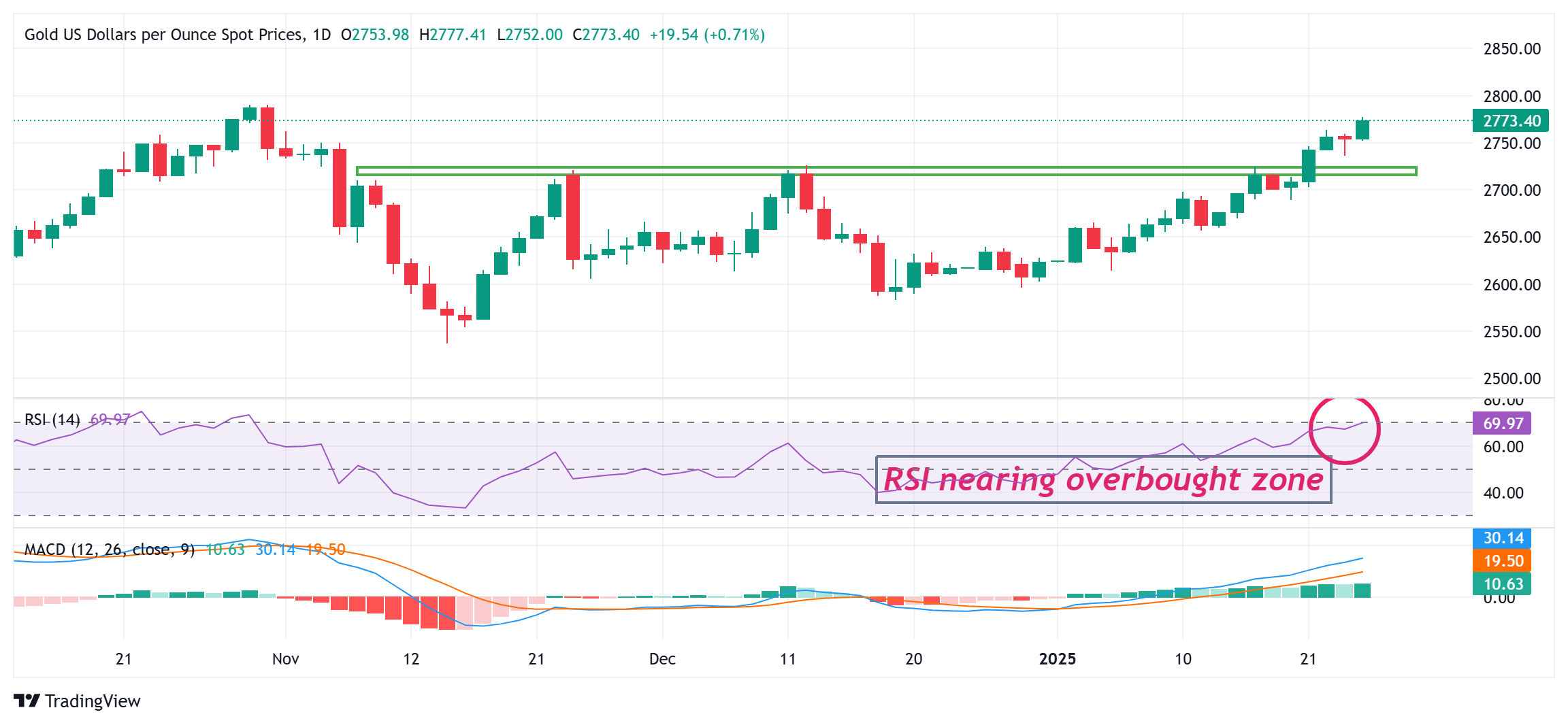- The price of gold receives new purchases on Friday and resumes an upward trend of more than a month.
- Concerns about a new wave of global trade wars support the safe haven commodity.
- Expectations of further Fed rate cuts weigh on the USD and further benefit the XAU/USD pair.
The price of gold (XAU/USD) regains positive traction after the brief pause of the previous day and rises to the $2,777 area, the highest level since October 31 during the Asian session on Friday. Investors remain concerned that US President Donald Trump’s trade policies could trigger trade wars and increase market volatility, continuing to drive flows into the safe-haven precious metal. Furthermore, the prospects of further interest rate cuts by the Federal Reserve (Fed) drag the US Dollar (USD) closer to the monthly low and prove to be another factor benefiting the non-yielding yellow metal.
Meanwhile, US President Donald Trump’s comments that he would prefer not to have to use tariffs on China provide an additional boost to global risk sentiment, although it does little to dent bullish sentiment around the price of gold. That said, slightly overbought conditions on short-term charts could hold back bulls from opening new positions around XAU/USD and positioning themselves for any further bullish moves. However, the commodity remains on track to post strong weekly gains and has now moved well within range of reaching the all-time high, around the $2,790 area touched in October.
Gold Bulls Remain in Control Amid Trump Uncertainty, US Dollar Weakness
- Investors remain concerned about the potential economic fallout from US President Donald Trump’s tariffs, continuing to drive the price of safe-haven gold higher on Friday.
- The US dollar retreats closer to the monthly low in reaction to Trump’s comments on Thursday that he will pressure the Federal Reserve to lower interest rates.
- Markets have begun to price in the possibility that the US central bank will reduce borrowing costs twice before the end of the year amid signs of easing inflationary pressures in the US.
- Trump said Friday that his conversation with Chinese President Xi Jinping was friendly and that he could reach a trade deal with China and would prefer not to use tariffs.
- This eases concerns that Trump’s protectionist policies could increase inflation and supports prospects for further policy easing by the Fed, benefiting the non-yielding yellow metal.
- Investors now await preliminary PMIs to gain fresh insight into global economic health, which could influence overall risk sentiment and move XAU/USD.
Gold Price Could Pause Near All-Time Peak, Around $2,790 Region
From a technical perspective, the emergence of some buying on Thursday and the subsequent move higher validates a bullish break through the $2,720-$2,725 supply zone. That said, the Relative Strength Index (RSI) on the daily chart is about to enter overbought territory, making it prudent to wait for a short-term consolidation or modest pullback before positioning for further gains. Therefore, the follow-through momentum is more likely to face a hurdle near the all-time peak, around the $2,790 region.
On the other hand, immediate support lies near the $2,760-$2,758 area, below which gold price could slide to retest the overnight low, around the $2,736-region. $2,735. Any further decline could be seen as a buying opportunity and remain capped near the support-turned-resistance of $2,725-$2,720. The latter should act as a key pivot point, which if broken decisively could shift the bias in favor of bearish trades and pave the way for further losses.
Gold FAQs
Gold has played a fundamental role in human history, as it has been widely used as a store of value and medium of exchange. Today, apart from its brilliance and use for jewelry, the precious metal is considered a safe-haven asset, meaning it is considered a good investment in turbulent times. Gold is also considered a hedge against inflation and currency depreciation, since it does not depend on any specific issuer or government.
Central banks are the largest holders of Gold. In their aim to support their currencies in turbulent times, central banks tend to diversify their reserves and purchase Gold to improve the perception of strength of the economy and currency. High Gold reserves can be a source of confidence for the solvency of a country. Central banks added 1,136 tons of gold worth about $70 billion to their reserves in 2022, according to data from the World Gold Council. This is the largest annual purchase since records exist. Central banks in emerging economies such as China, India and Türkiye are rapidly increasing their gold reserves.
Gold has an inverse correlation with the US Dollar and US Treasuries, which are the main reserve and safe haven assets. When the Dollar depreciates, the price of Gold tends to rise, allowing investors and central banks to diversify their assets in turbulent times. Gold is also inversely correlated with risk assets. A rally in the stock market tends to weaken the price of Gold, while sell-offs in riskier markets tend to favor the precious metal.
The price of Gold can move due to a wide range of factors. Geopolitical instability or fear of a deep recession can cause the price of Gold to rise rapidly due to its status as a safe haven asset. As a non-yielding asset, the price of Gold tends to rise when interest rates fall, while rising money prices tend to weigh down the yellow metal. Still, most of the moves depend on how the US Dollar (USD) performs, as the asset is traded in dollars (XAU/USD). A strong Dollar tends to keep the price of Gold in check, while a weaker Dollar is likely to push up Gold prices.
Source: Fx Street
I am Joshua Winder, a senior-level journalist and editor at World Stock Market. I specialize in covering news related to the stock market and economic trends. With more than 8 years of experience in this field, I have become an expert in financial reporting.








